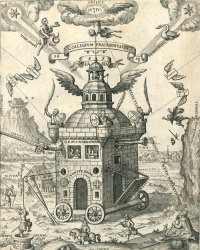Daniel Mögling (1596–1635)
From The Art and Popular Culture Encyclopedia
(Difference between revisions)
| Revision as of 11:08, 8 February 2009 Jahsonic (Talk | contribs) ← Previous diff |
Revision as of 11:36, 8 February 2009 Jahsonic (Talk | contribs) Next diff → |
||
| Line 1: | Line 1: | ||
| [[Image:Speculum Sophicum Rhodostauroticum.jpg|thumb|right|200px|Illustration to the ''[[Speculum Sophicum Rhodostauroticum]]'' ([[1618]]) by [[Teophilus Schweighardt Constantiens]]]] | [[Image:Speculum Sophicum Rhodostauroticum.jpg|thumb|right|200px|Illustration to the ''[[Speculum Sophicum Rhodostauroticum]]'' ([[1618]]) by [[Teophilus Schweighardt Constantiens]]]] | ||
| {{Template}} | {{Template}} | ||
| - | :''[[speculum literature]], [[Rosicrucian]] | + | :''[[speculum literature]], [[Rosicrucian]], [[esoteric Christianity]]'' |
| '''Daniel Mögling''' (pseudonym ''Teophilus Schweighardt Constantiens'') is the [[Alchemy|alchemist]] who allegedly wrote the work ''[[Speculum Sophicum Rhodostauroticum]]'' ("The Mirror of the Wisdom of the Rosicrucians"), in [[1618]]. | '''Daniel Mögling''' (pseudonym ''Teophilus Schweighardt Constantiens'') is the [[Alchemy|alchemist]] who allegedly wrote the work ''[[Speculum Sophicum Rhodostauroticum]]'' ("The Mirror of the Wisdom of the Rosicrucians"), in [[1618]]. | ||
Revision as of 11:36, 8 February 2009

Illustration to the Speculum Sophicum Rhodostauroticum (1618) by Teophilus Schweighardt Constantiens
|
Related e |
|
Featured: |
Daniel Mögling (pseudonym Teophilus Schweighardt Constantiens) is the alchemist who allegedly wrote the work Speculum Sophicum Rhodostauroticum ("The Mirror of the Wisdom of the Rosicrucians"), in 1618.
In the Speculum, he repeatedly refers to Thomas a Kempis's Imitatio Christi as a major source for Rosicrucian thought. Mögling allegedly did not believe in the actual existence of the Rosicrucian Brotherhood, but adhered to its theosophical and pansophist principles. The four engravings in the Speculum offer an ‘orbis pictus’ of the Rosicrucian movement and were to provide lasting inspiration for later Rosicrucian iconography.
See also
Unless indicated otherwise, the text in this article is either based on Wikipedia article "Daniel Mögling (1596–1635)" or another language Wikipedia page thereof used under the terms of the GNU Free Documentation License; or on research by Jahsonic and friends. See Art and Popular Culture's copyright notice.

